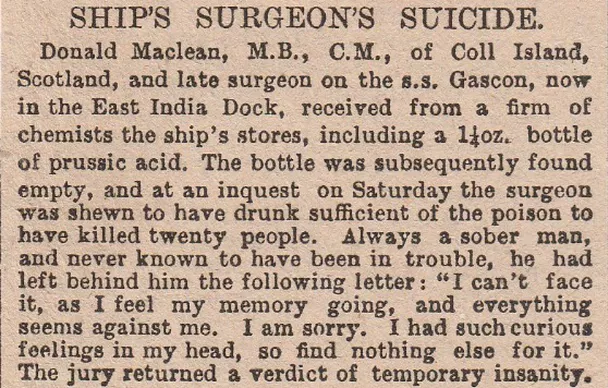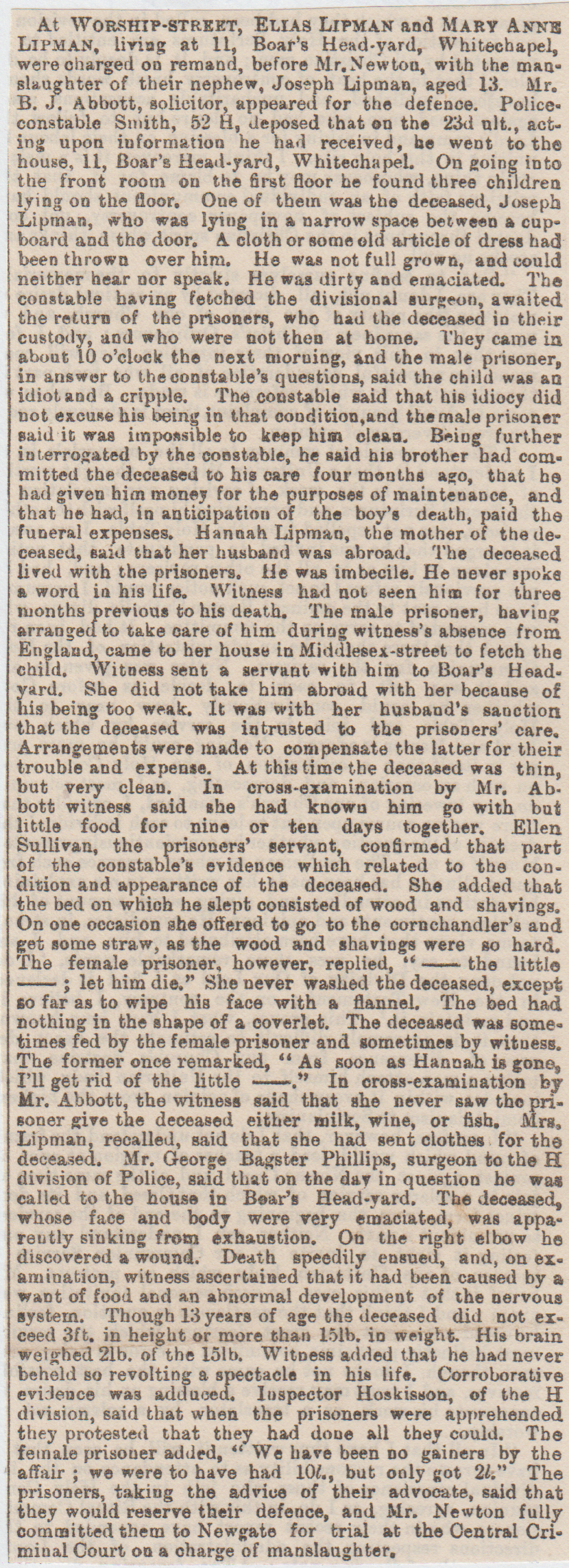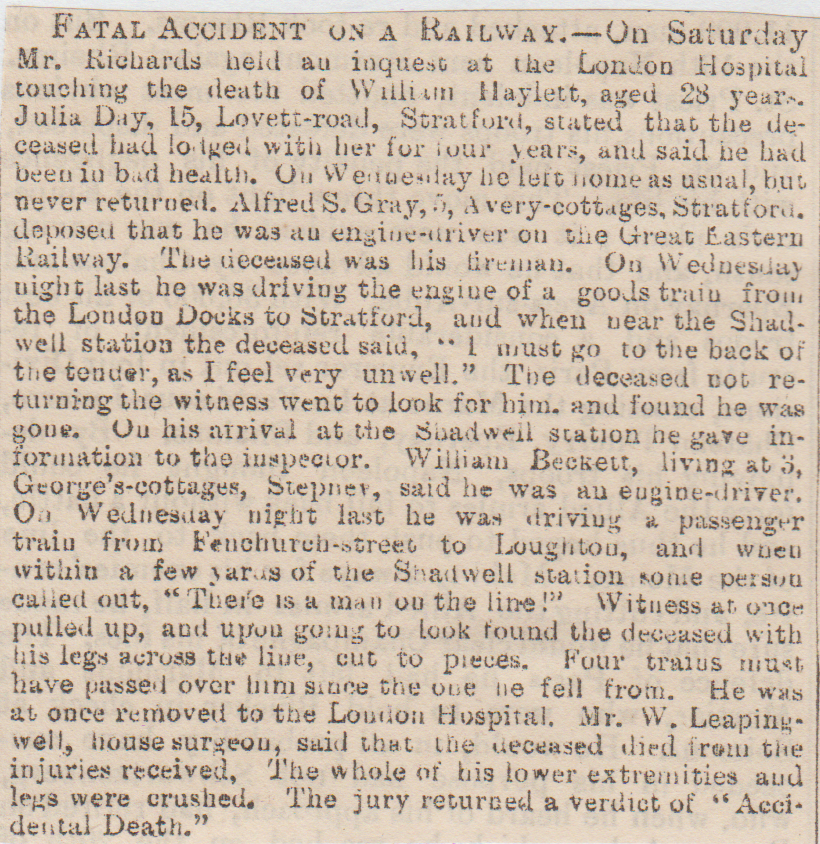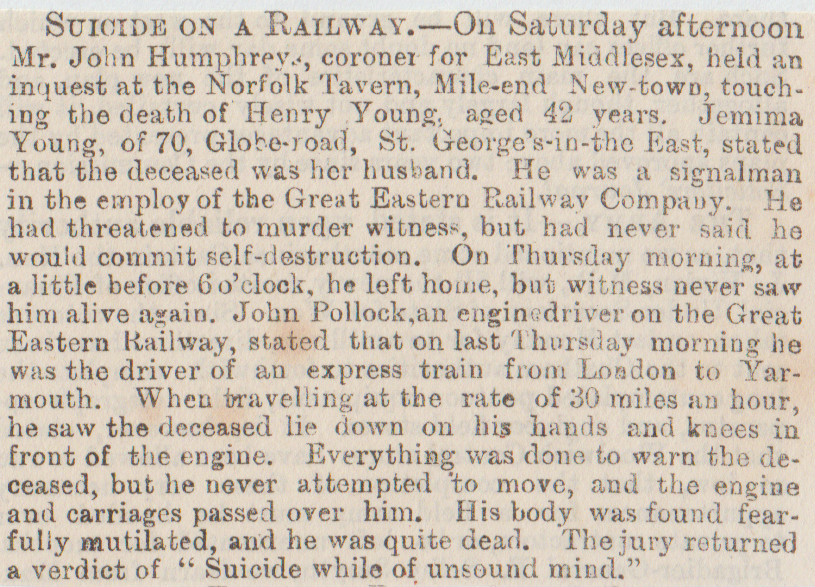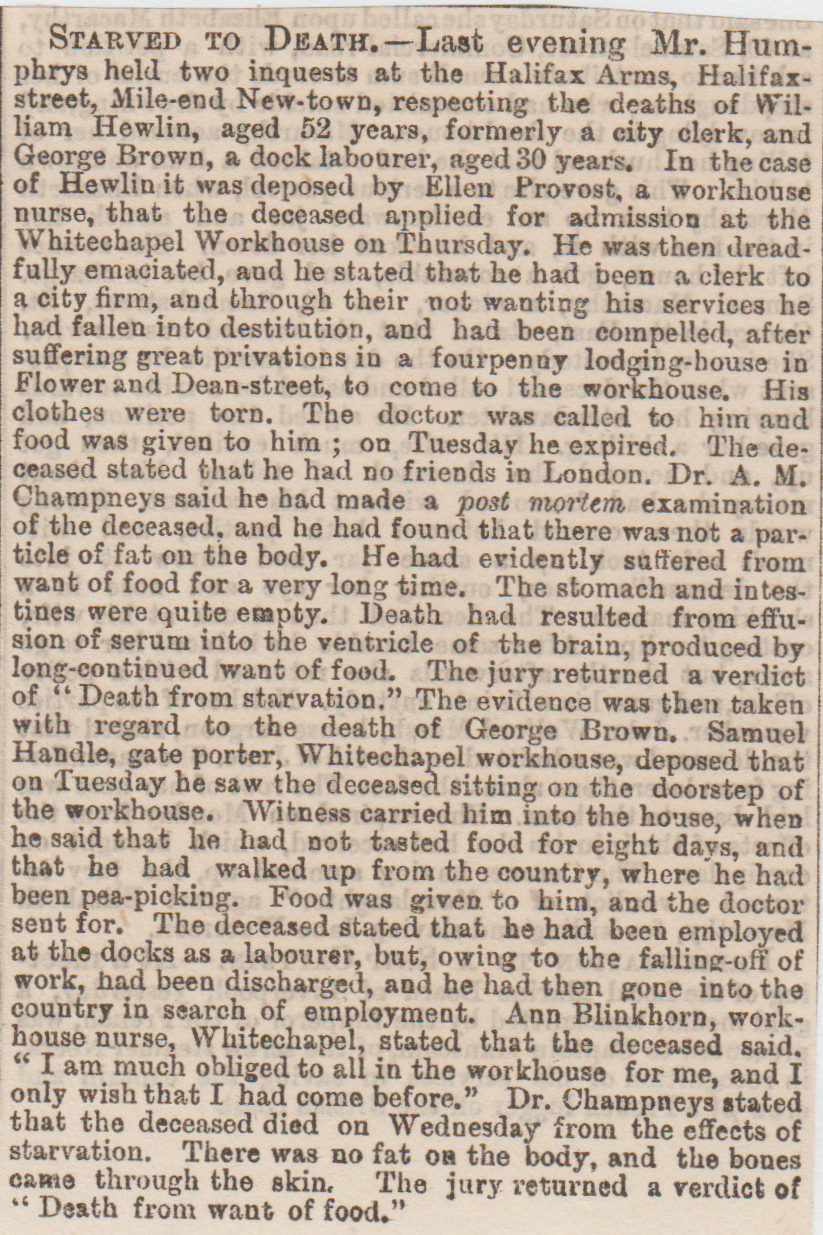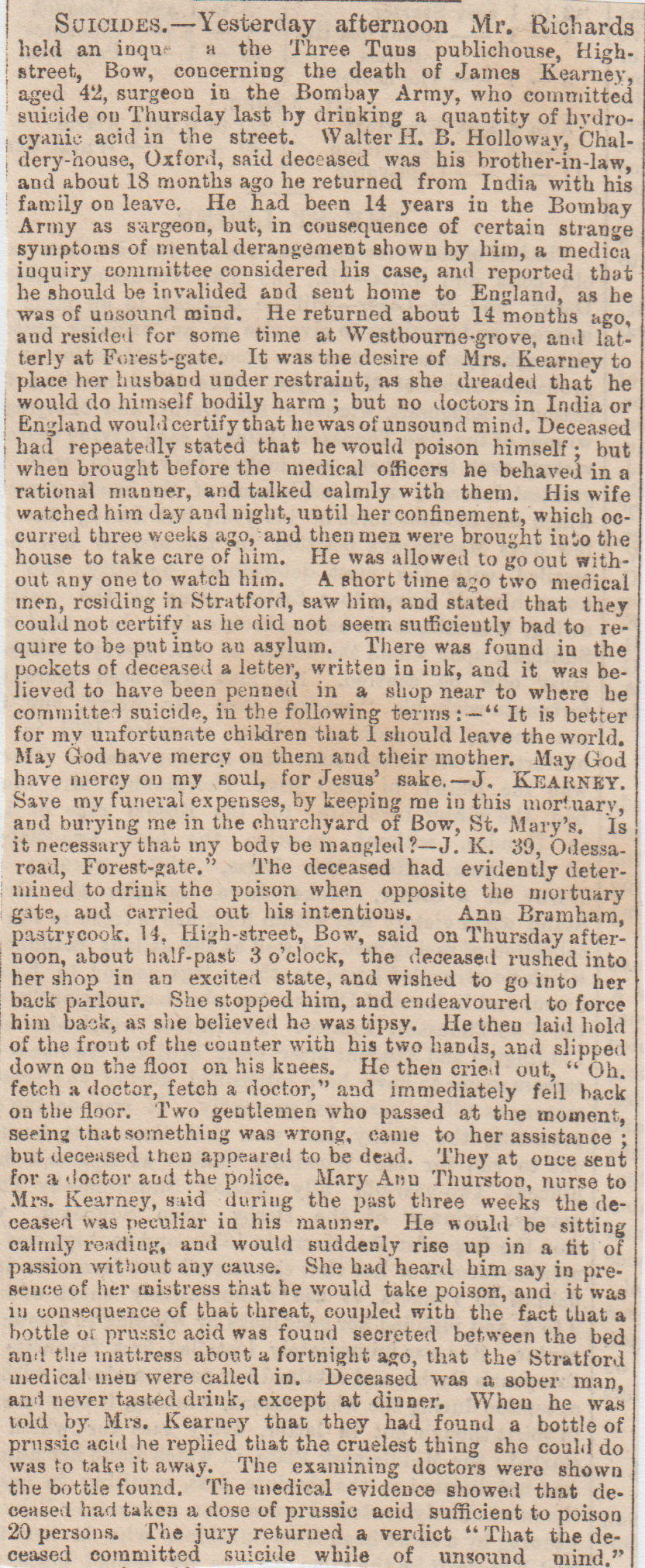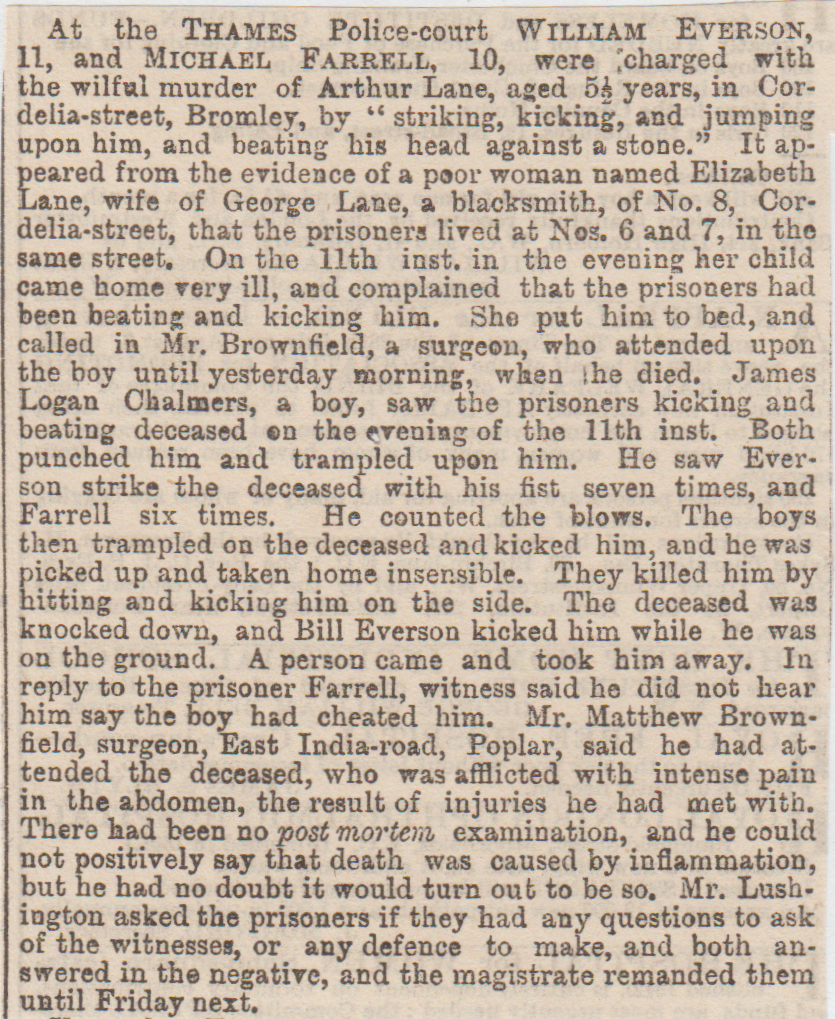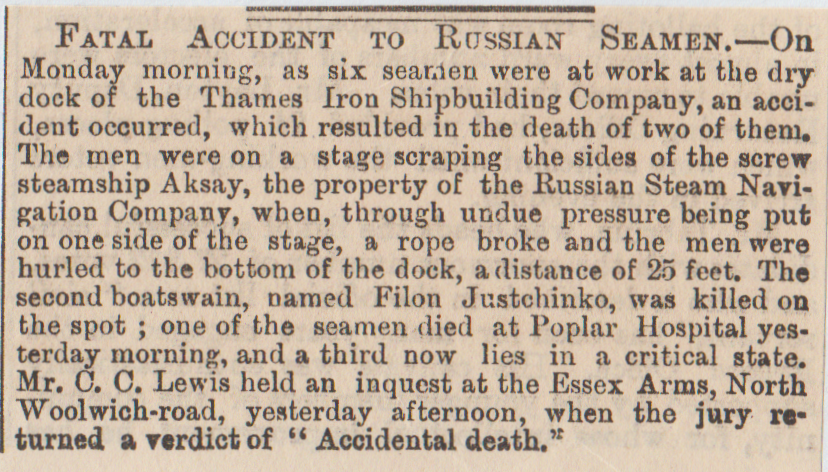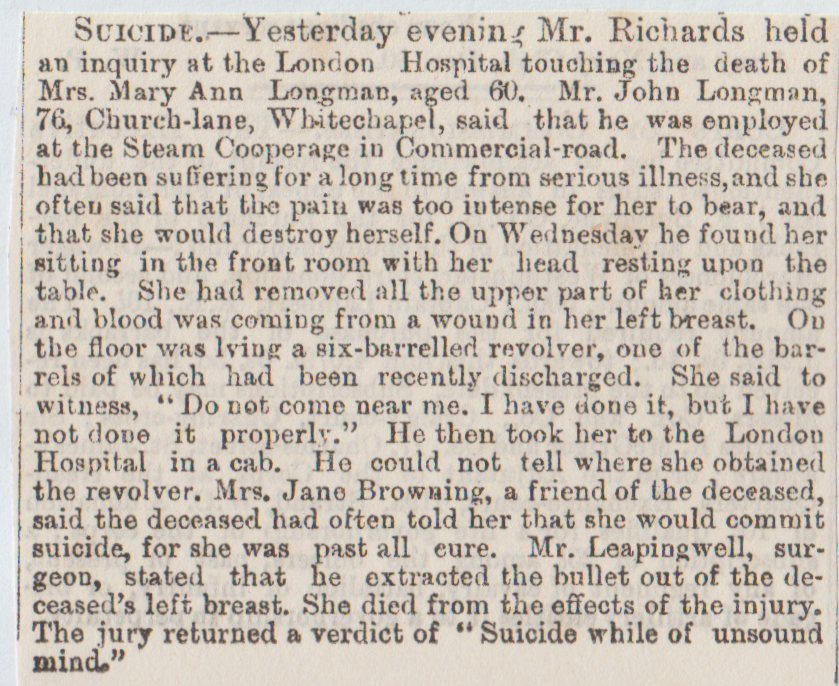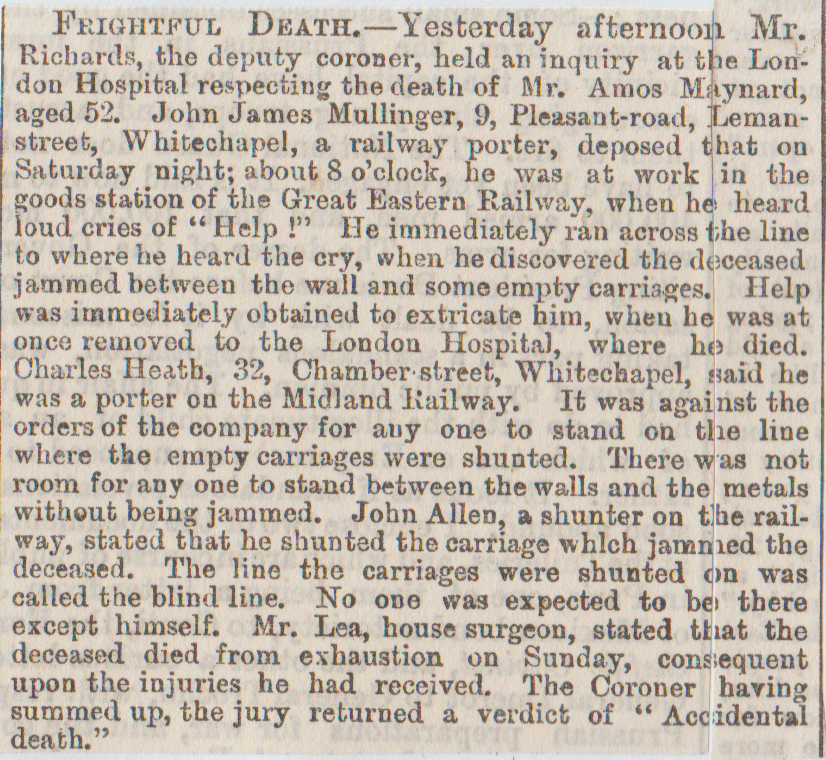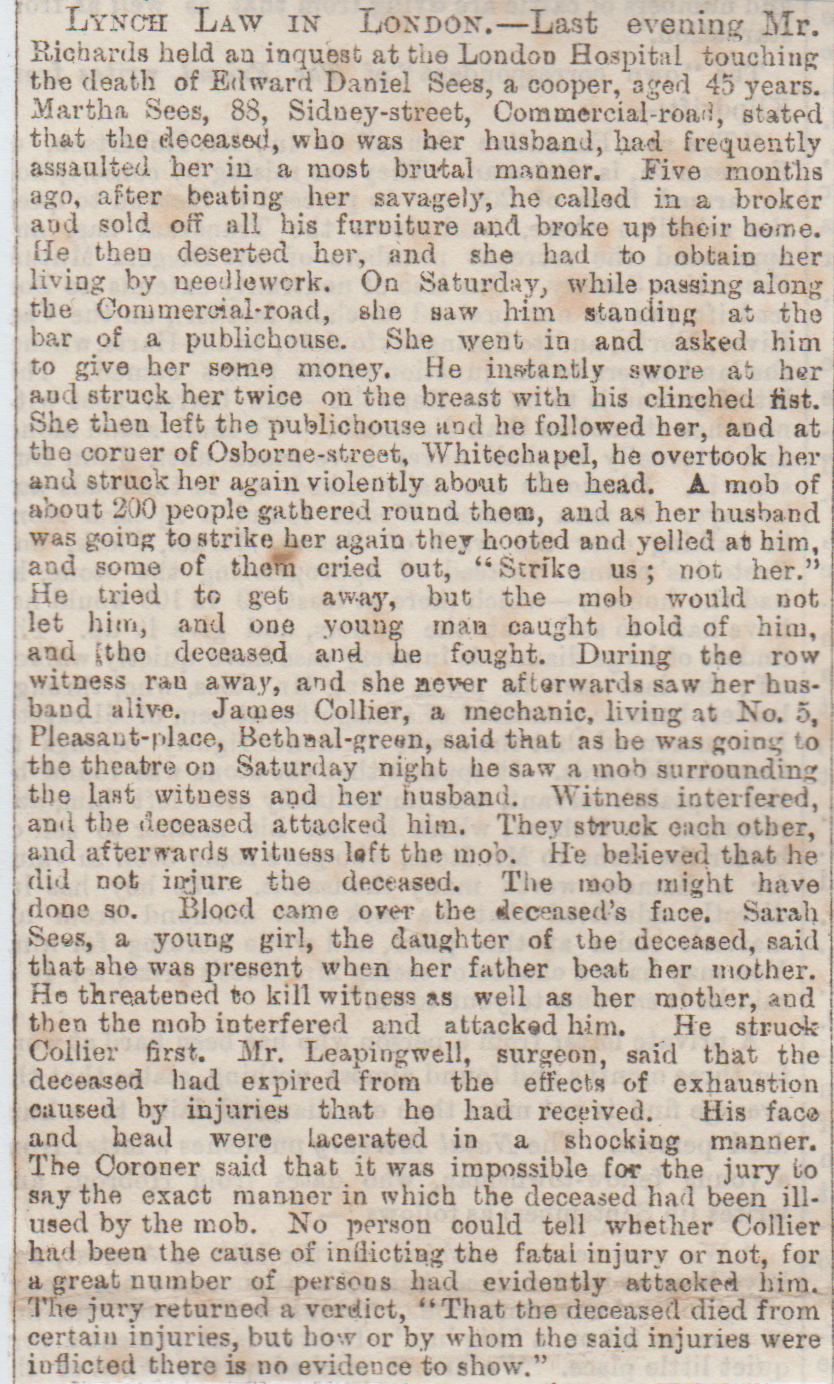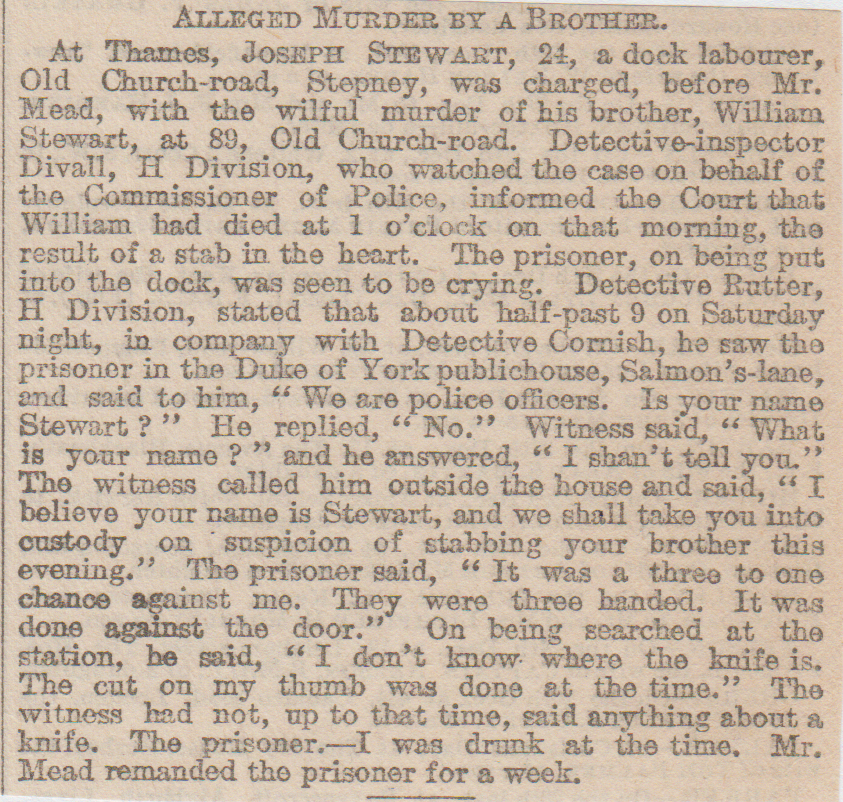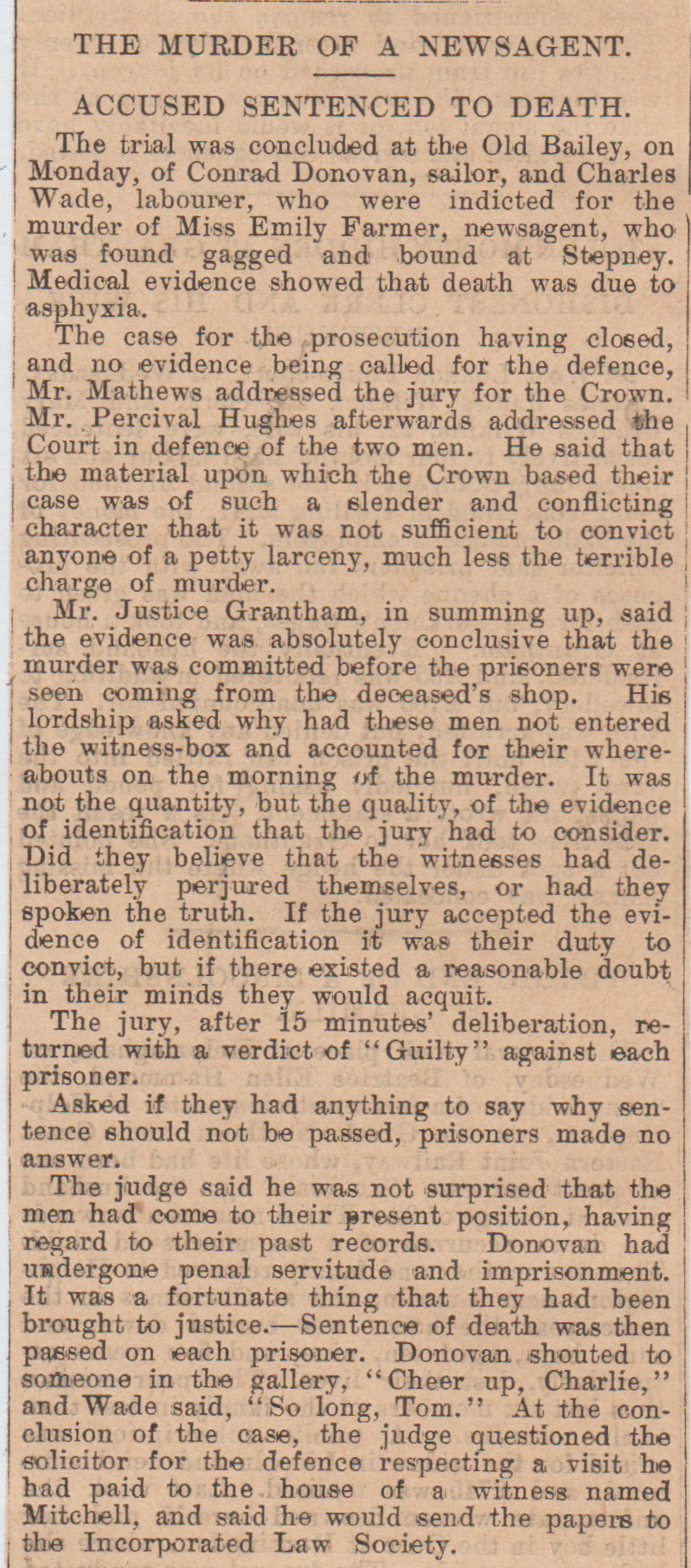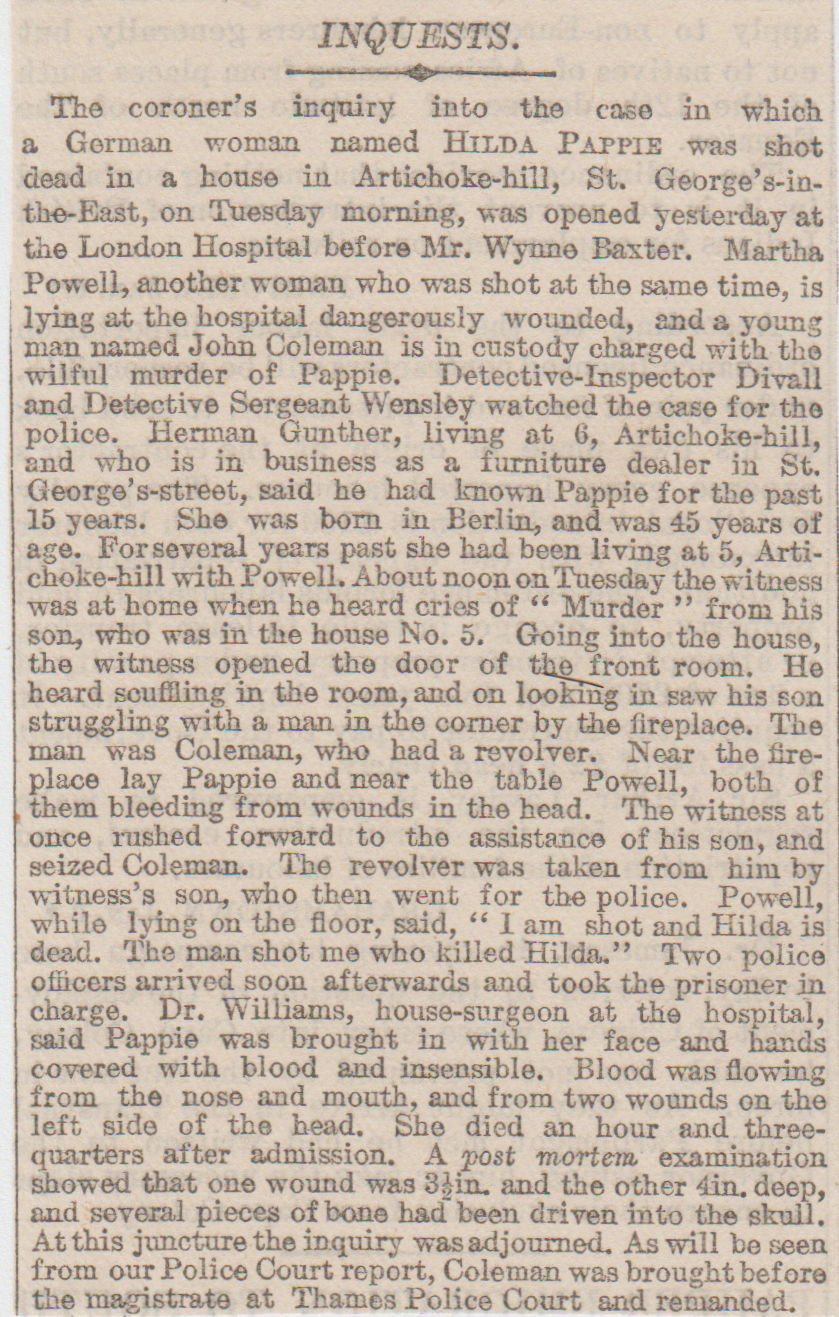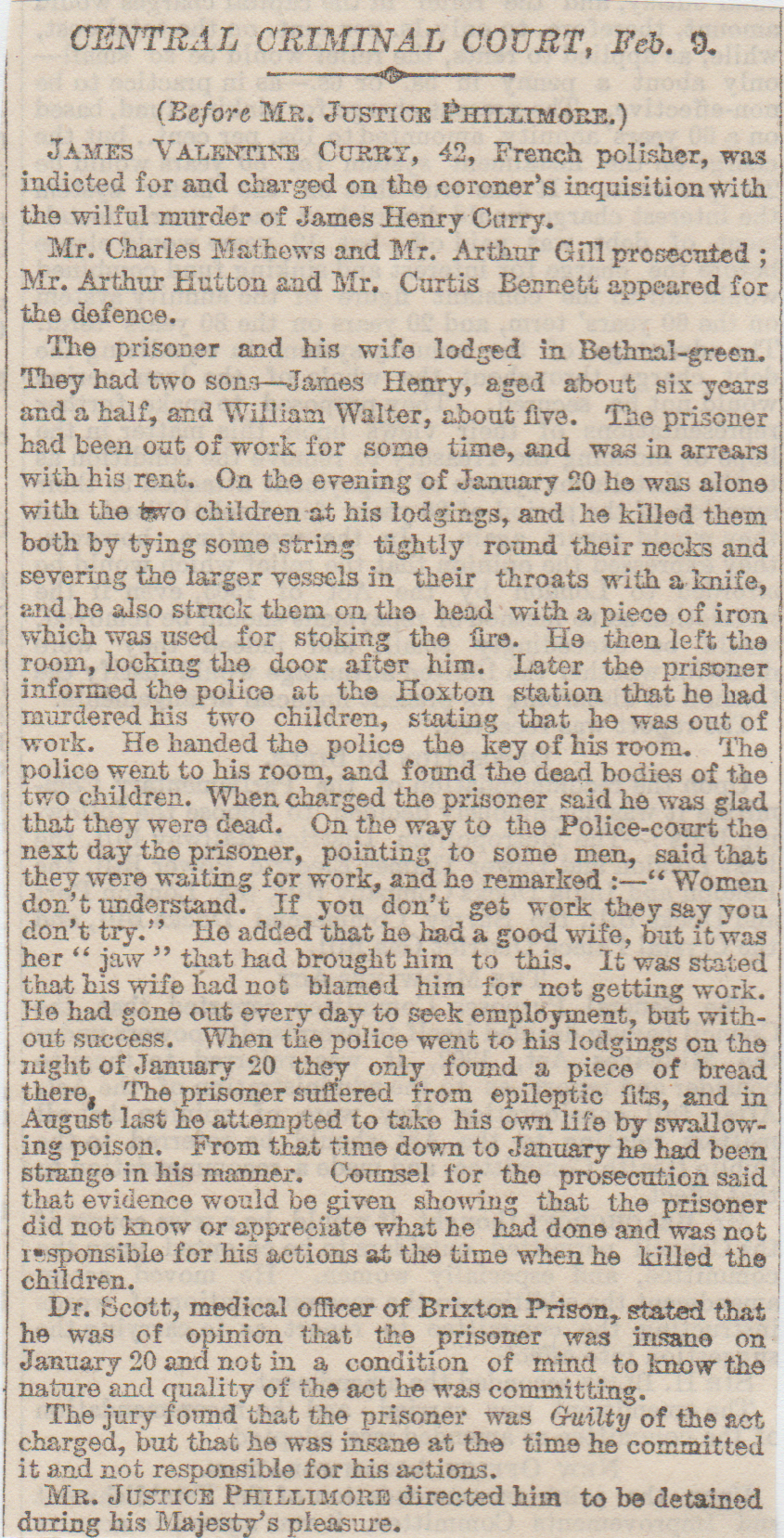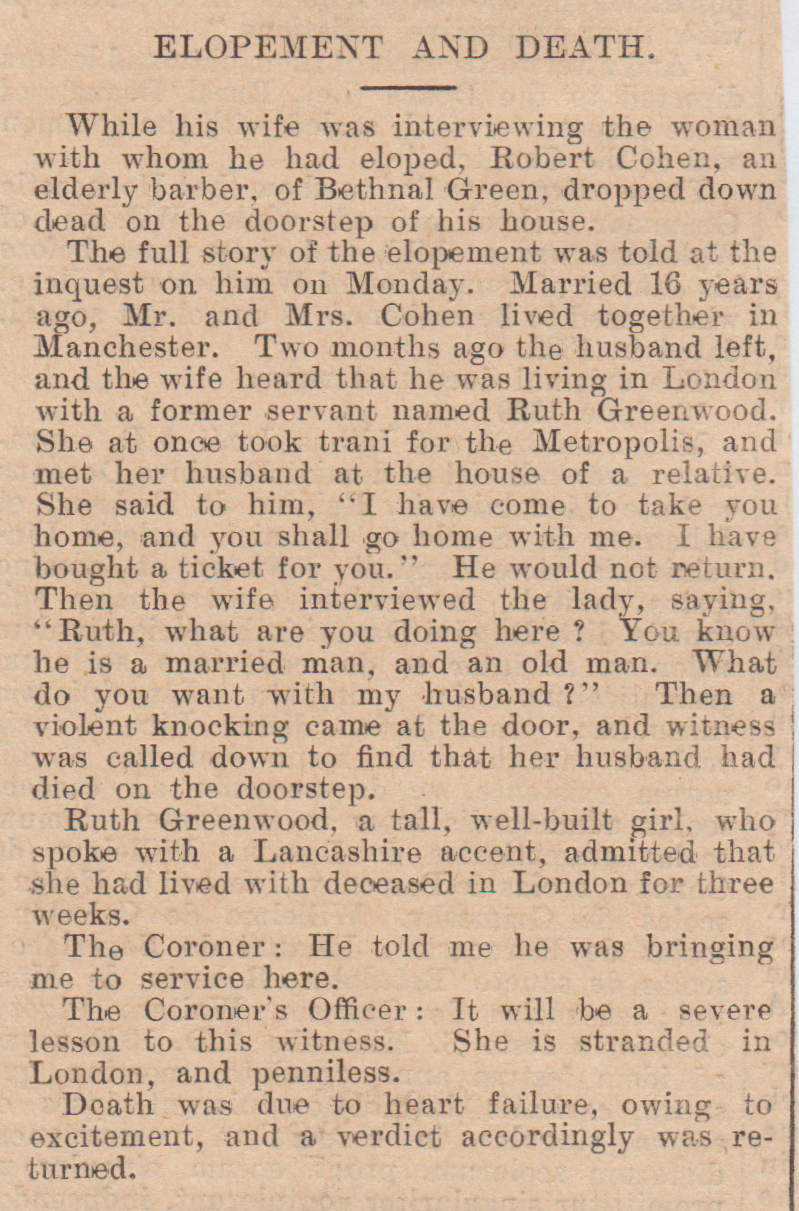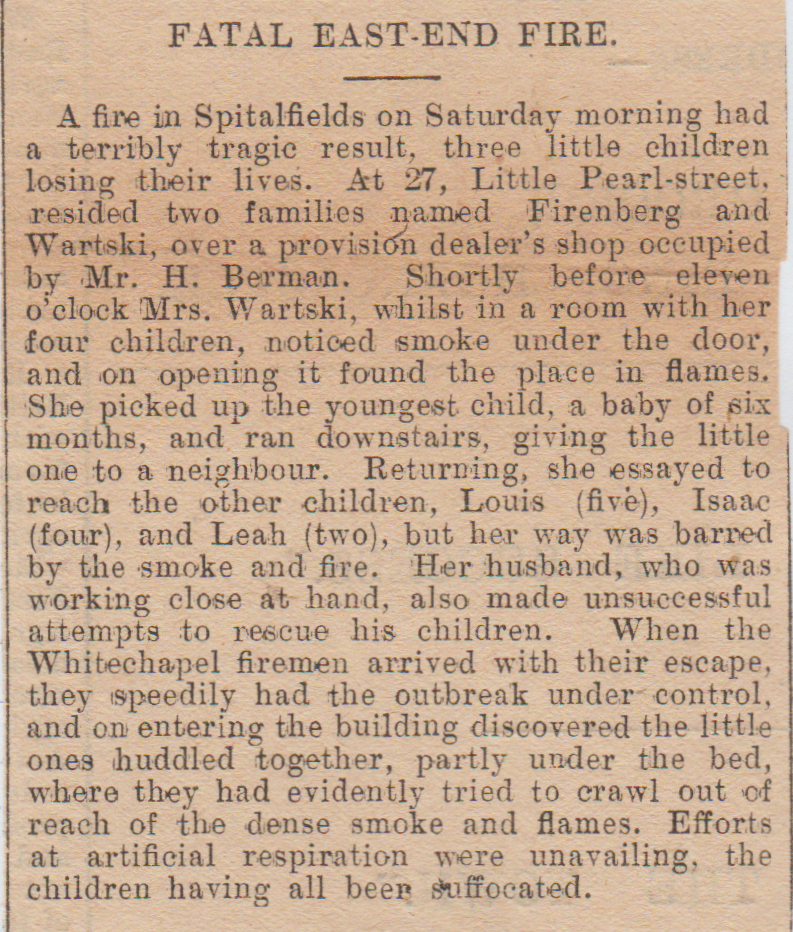1/ Whitechapel Murder, July 1887. (This murder occurred in Whitechapel the year before the Ripper. Did Lepski live or die?)

2/ Whitechapel Murder, August 31st, 1888
This is the low-key article on the first of the Ripper’s victims, Mary Ann Nichols, who was butchered at Bucks Row. Didn’t want to overdo the Ripper theme for Tower Hamlets, so here are a couple to muse over.
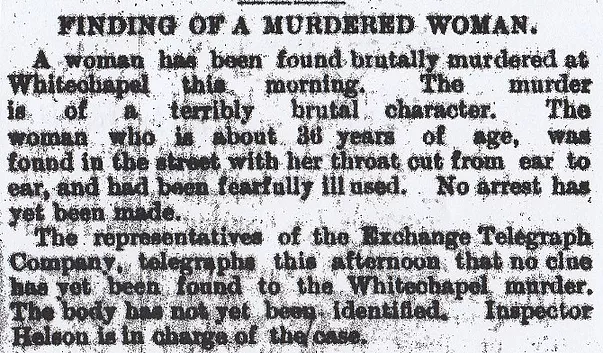
3/ Whitechapel Murder, August 1888 (Dry run for the Ripper?)
About five a.m, one morning, a body of a woman was found at 37, George-yard Buildings, Whitechapel, on the first-floor landing. Doctors arrived but it was far too late. The woman had been horribly mutilated. There were stab wounds to the chest, stomach and abdomen. She was about thirty-five years of age and not known in the area. No disturbance was heard. (This bears all the hallmarks of Jack the Ripper- the district, the modus operandi and the fact it was done with nobody seeing or hearing a thing. (It’s got to be, hasn’t it?) This was early August and Mary Ann Nichols, his first, was on August 31st.
4/ Whitechapel Murders, October 30th, 1889
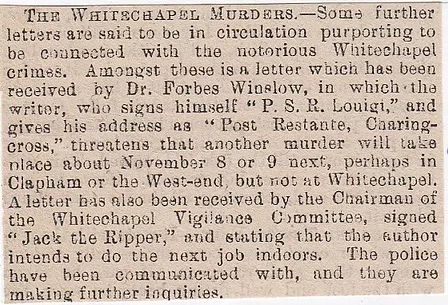
This is more media hype I found, which is to do with the Whitechapel Murders. The letter was clearly a hoax. One thing I didn’t know about this, was that there was a Whitechapel Vigilance Committee.
5/ St Katherines Dock, (Lift Accident) March 1909
An awful accident took place at St Katherines Dock when a lift chain snapped and sent the occupants hurtling to the ground, a distance of forty feet. One died on the spot, another on his way to London Hospital and a third has died in Hospital. The group of labourers were on there way to dinner-break, when the machinery malfunctioned, the chain broke and sent the men to the bottom of the shaft. The names of the dead are- John Homer, John Harrington and Charles Hamton.
6/ Commercial Road, Limehouse, February 1899
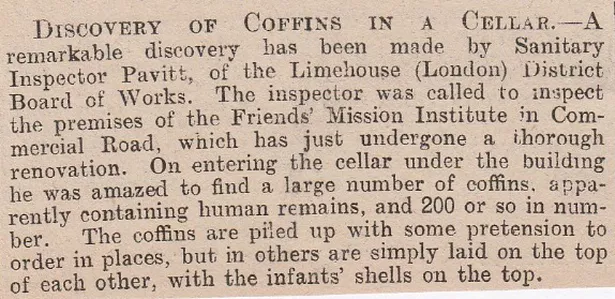
7/ Britannia Music Hall Fire Fatality, High Street, Shadwell, December 1858
Sad story about Emily Ann Harlow aged nine, who was on stage at the Britannia Music Hall, doing her ballet routine on Boxing Day. The stage is fairly small and during a pantomime scene, her little dress flicked the footlights and her dress caught fire. Before the flames could be put out, the little girl had received major burns. She was rushed off to London Hospital, but she died a couple of days later. (Is it still there?)
8/ Cubitt Town, Poplar, (Concealment of Birth) March 1890
A parcel was discovered in Cubitt Town, Poplar lying in the street. When opened, inside was a dead baby boy and a rather sad note, explaining the circumstances.
“Poplar- I had no means of saving my baby’s life. I fainted, and when I came round, my baby was dead. Its father turned me up, and I cannot let my mother or my mistress know, as I should then be done for-L.B.”
9/ North Britain Public House Suicide, Mile End, April 1888
The landlord of the North Britain public-house in Mile End was chatting to a customer by the name of Frederick Bunkworth. The place was chock-a-block when suddenly the 48-year-old put his handkerchief up to his face, then there was a loud bang and he dropped to the floor. Inside the hanky was a pistol and the contents of which was now lodged in his brain, causing instant death.
(North Britain pub was at 83, Bedford Street, which is now Cavell Street. It is in Stepney, near to London Hospital, Whitechapel)
10/ Queen Anne Street, Whitechapel, March 1890 (Fatal Fight)
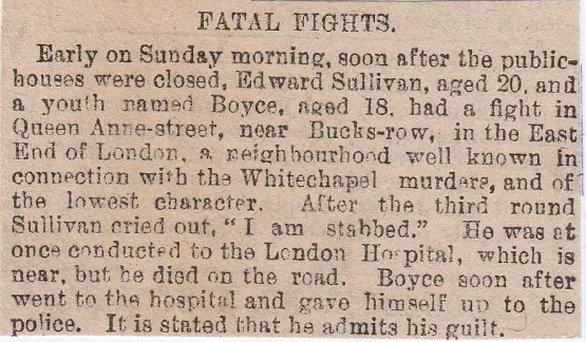
11/ The Bow Murder, November 1885
At the Central Criminal Court yesterday before Mr Justice A.L.Smith, Daniel Monahan aged twenty-eight, was indicted for the wilful murder of his wife Bridget. The jury, after a short deliberation, found the prisoner guilty. Mr Justice Smith having assumed the black cap, passed sentence of death upon the prisoner, who did not exhibit the least emotion and left the dock without saying a word.
12/ Poplar Fire Fatality, March 1885
During a fire which occurred on Saturday morning in a dwelling-house at Poplar, an old woman named Dipple, related to the occupant, was burned to death.
13/ St George in the East Skeleton, August 1886
While digging a trench for a gas pipe for the Commercial Gas Company, the workmen made an amazing discovery. Where Cable Street and Cannon Street Road cross and about six feet underground, they unearthed a male skeleton with a stake driven through it and with some pieces of an old chain lying next to him. It is thought to be the skeleton of a murderer who while imprisoned in Coldbath Fields Prison (Clerkenwell Gaol), had committed suicide by hanging himself in his cell and was buried as a suicide.
14/ Ocean Street, Stepney, August 1885
A fire was caused on Saturday night at 73, Ocean Street in Stepney by the occupier, Mr Merry, falling and upsetting a spirit lamp he was carrying. The flames catching his clothing burnt Mr Merry so severely that he died on Sunday morning.
15/ Cuba Street Husband Murder, Millwall, April 1885
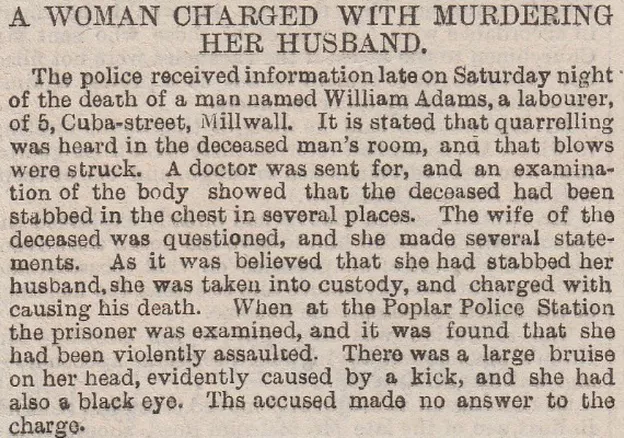
16/ Brushfield Street, Spitalfields, July 1890 (Barbershop Suicide)
A stranger to the area walked into the barber’s shop on Brushfield Street in Spitalfields and inquired about the cost of a razor. He bought one, then he immediately slit his throat with it and expired within five minutes.
17/ White Hart Public House Murder, Shadwell, February 1879
James Sims, the glass-collector at the White Hart public house in Shadwell, appeared in court on a charge of murdering Annie Smith. He cut her throat with a razor in the bar of the above-mentioned premises. (Is it still there, or now a block of flats?)
18/ London Hospital Suicide, September 1850
This is how things have changed in British hospitals throughout the decades.Thomas Beckley aged thirty-nine was in for dyspepsia, or indigestion as we know it today, but his hypochondria had got the better of him as he thought it was life-threatening. While the other patients were eating and the nurses were busy with other things, he grabbed a knife and made a gash in his throat. He tried in desperation to tear the wound open with his bare hands but was stopped by a nurse. He passed away the next morning due to the severity of his injuries.
19/ Oxford Street Fire, Whitechapel, June 1885
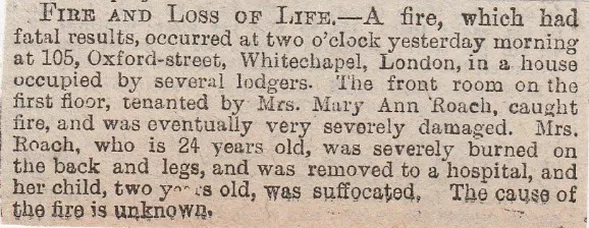
20/ Tredegar Square Skeleton, Mile End Road, August 1880
There was a buzz in the neighbourhood of Mile End Road, by a rumour that a skeleton had been discovered in the centre of Tredegar Square. A gardener was digging in the patch of grass when he stumbled upon a human skull, which had been thrown there the night before. Police were called for and a couple of bobbies got digging in the general area and they found the skeleton about a foot under the surface. There is a hole in the skull, which looks as though it was caused by a blunt force. Tredegar Square is one of East London’s largest and most respectable squares.
21/ Hanbury Street Suicide, Spitalfields July 1895
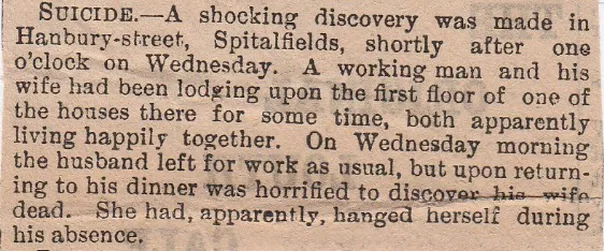
22/ Whitechapel Church, (Child Bodies), August 1864
Near to Whitechapel Church, a horrible discovery was made early one morning. The area long had reputation for the burial scandals, whereupon the bodies of small children would simply be dumped somewhere, but the fee for burying would have been collected. This has stirred up a hornet’s nest again. Near to the Church were the corpses of eighteen children and they were simply covered over with refuse. Some were recently placed there, with some others that were decomposed and some without heads.
23/ Millwall Fatal Quarrel, August 1892

24/ Bow Lunatic Suicide, October 1862
40-year-old lunatic Benjamin Ward made an escape from Grovehall Asylum in Bow, was recaptured and then he committed suicide. He made his escape by squeezing himself through a vent in the window, then scrambled through the garden and over the wall. The alarm was raised, but he ran like a greyhound and was off the establishment premises. Unluckily while on Mile End Road he was spotted by Gilbert, the barber at the asylum and he managed to coax him back to the asylum. Once back inside the asylum, Ward was missed for a minute and thinking he had again made a run for it again, they searched the asylum and grounds. They found him hanging from his bedstead with a piece of rope he purchased while he was on the run. The deceased made a run for it, after having a vision that his wife had died. Amazingly in an asylum of 100-200 suicidal inmates, this is only the second instance of someone killing themselves, as they have a “cheerful unrestraining system”, which seems to be working wonders in this establishment.
25/ Gill Street, Limehouse, March 1890 (Fatal Fire)

26/ Bethnal Green, January 1917 (Suicide to help win War)
William Platt Ball aged seventy-two, killed himself by taking poison at Bethnal Green. He left a suicide note and thought he was helping the war effort. It read :
“I am taking poison to end my life, as my ailments are becoming unbearable, and as being by far the simplest of problems before me. I also wish to leave what little property I possess to my blind niece. If I were to live this would disappear. By my act I shall be economising by saving the whole expenses of living. I shall therefore in this be patriotic, although I confess it is not my deciding motive.”
27/ Poplar, (Fatal Accident Repeated) October 1833
A terrible accident at Mr Mellish’s premises at Millwall, Poplar, has resulted in the death of one man. John Skinner, a shipwright, was carefully moving around the warehouse in the dark when he fell through a scuttle-hole in the tank, which had forty tons of whale oil in it. He struggled for a bit and then sank to the bottom. Workmen dragged the body out but he was dead, from swallowing a gallon of the liquid which ultimately suffocated the poor chap. This is not the first such accident of this kind at these premises, as seven years ago a man died in the exact same way, in the exact same tank.
28/ Millwall Docks, August 1885 (Sweden to Hull Voyage- ends up in Millwall)
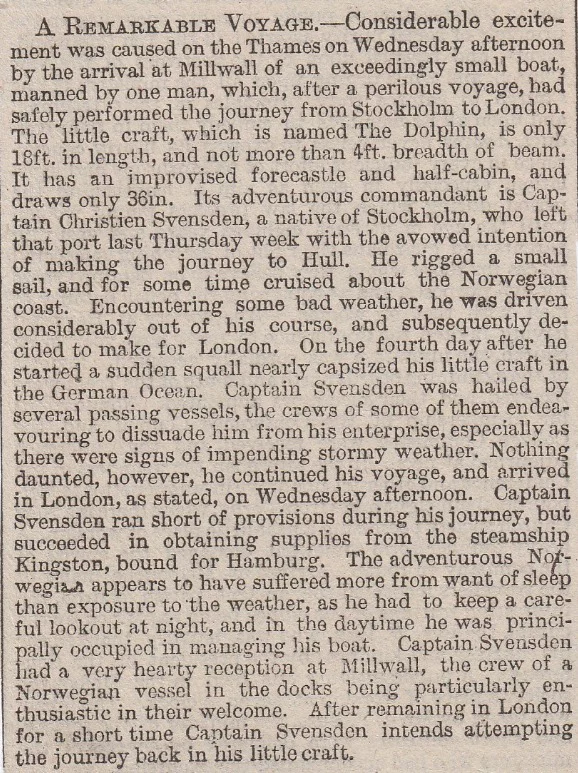
29/ Stepney Fair Death, June 1846
A young lad of about twelve years of age was having a great time at Stepney Fair by pretending to push around a “carousel ride”, and somehow he got caught in the workings of the ride, in particular, the chains which brace it together and this tore his leg clean off, from just below the knee. He was whisked off to the London Hospital, but his chances of survival are virtually nil.
30/ Society of Friends, Bakers Row, Whitechapel, March 1845 (Grave Fatality)
At the Society Of Friends burial ground in Bakers Row, Whitechapel, there was a dreadful fatality. The victim was the sexton, George Stevens who was aged about fifty. He had gone to the bottom of a freshly dug grave to check if it was level and when the maid called him into the house for dinner, there was no answer, so she went to the grave-side and found him lying there. The body showed no signs of life and a medic said he’d been dead quite a while.
31/ Poplar/Millwall Servant Suicide, March 1864
The inquest into this teenager’s suicide was held at the Black Horse Tavern in Poplar, so I presume she died somewhere nearby. This is about sixteen-year-old Mary Cooke whose mother lived in Millwall. Mary was a domestic servant but she had a short fuse and was liable to pack in jobs just like that. Her mother said that if she didn’t stick out this job then she shouldn’t come crying to her for help. Mary left the job because her Jewish employer had charged her two months wages for a cape. Instead of going home, she went and jumped into the Thames.
32/ Ettrick Street Murder, Poplar, December 1885
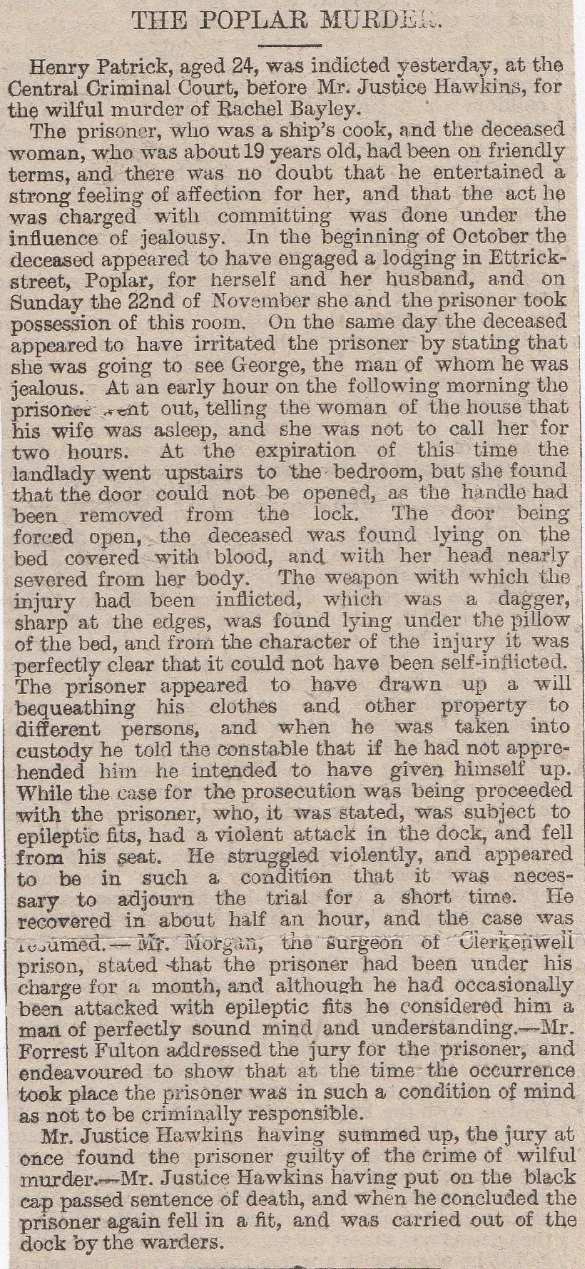
33/ Mare and Co.Foundry, Blackwall, July 1852 (Burned to a Crisp)
About a dozen men were busy at the Mare and Co Foundry in Blackwall preparing a huge casting, which meant that they had to melt the iron into liquid form. About twelve tons of the molten metal was released into a ladle, which is on wheels, while several men push it along to its final destination. Everything was going smoothly until a wheel snapped off and sent the liquid all over the shop. Most of the men suffered some major burns in some way or other, such as feet, arms, legs and faces being the common ones. One of the workmen was found burnt to a crisp under the liquid metal and as yet he remains unidentified.
34/ Bethnal Green, (Suicide in front of Daughter) January 1866
Living with her unemployed husband at No 2, Nottisford Street, Bethnal Green, was Mary Manning who at this time was ill in bed. Mary got her daughter, Ellen, to fetch her the razor from the bathroom. Alarm bells rang in Ellen’s head and she rightly refused. The mother got nasty and shouted at her “If you do not do so, the first time I get hold of you, I will cut your throat”. She was that scared she complied with her order. While her daughter stood in front of her, she calmly slit her throat from ear to ear. The girl screamed out and the neighbour came running in.While lying on the floor dying of blood-loss, Mary Manning stuck two fingers in the gash and began to tear it open. The neighbour, Elizabeth Madox, tried to stop her but Mary resisted and attacked her. Finally, she was overpowered and despite the attentions of doctors, she died within half an hour. (Is Nottisford Street still there?)
35/ Whitechapel Murder/Suicide, February 1888

36/ Pitt Street, Hackney Road, April 1868 (Dead Infant in Attic)
A new tenant who’d just moved into No 31, Pitt Street, Hackney Road, found the dead body of a small child between the ceiling and the roof of the house while repairing it. Another lodger at the property, William Powers, said he had lived there for two and half years and remembers a young lady had an illegitimate child while there. He thought that was alive when born. Then two women moved in but they were raucous in their behaviour, so he had them removed from the property. They refused, so he moved instead, a month ago. Post-mortem results suggest that the child had been dead for about seven or eight months and the cause of death is near impossible to determine.
37/ St Georges-in-the-East, (Suicide in Cellar) October 1880
A man named Hebbs, who resided in a lodging-house in St Georges-in-the-East called on a policeman, as he had just found a dead body in the cellar. Hebbs said he went to get some coal when he saw the corpse lying on the coal heap. After talking to it, then prodding it, he realised the chap was lifeless. The body was well-dressed and about five feet eight inches tall and in his mid-forties, with greying hair. He had no cash on him, but a piece of paper with”Oxalic acid-M.G.Buckner, chemist, High St, Whitechapel” on it. It is believed that this fairly well-to-do gentleman, bought the oxalic acid and then crawled into the coal cellar to commit suicide.
38/ Rutland Street Murder, Mile End, March 1885
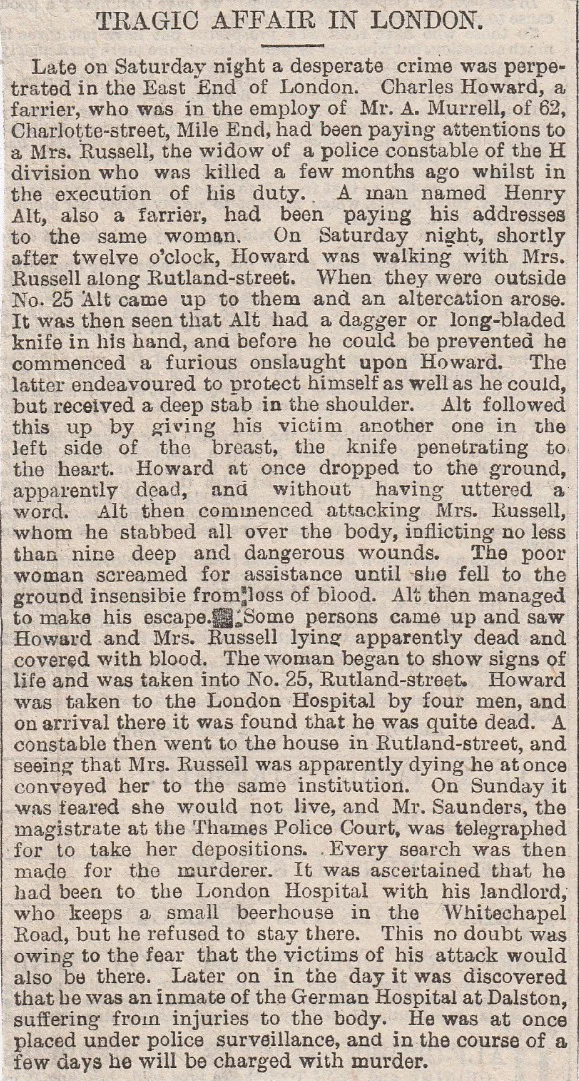
39/ Mile End Road Suicide, November 1880
P.C. George Bishop was called to 409, Mile End Road, and when he arrived he saw the blood-soaked naked body of a woman in front of a mirror with her throat slashed. Next to her was a carving knife which was ascertained to be the suicide weapon. The woman was twenty-four-year-old Emma Jane Venables, whose father was an ex-policeman who died a few months ago. The theory is that she stood in front of the mirror, slit her throat, then fell down and bled to death. Emma had been rather sullen since her father’s death and it had been affecting her mind. The building at 409, Mile End Road is still there, it is directly across the road from Mile End Station, but now, as of 2016, it is a business involved in housing.
40/ Stepney Station Fatality, August 1892
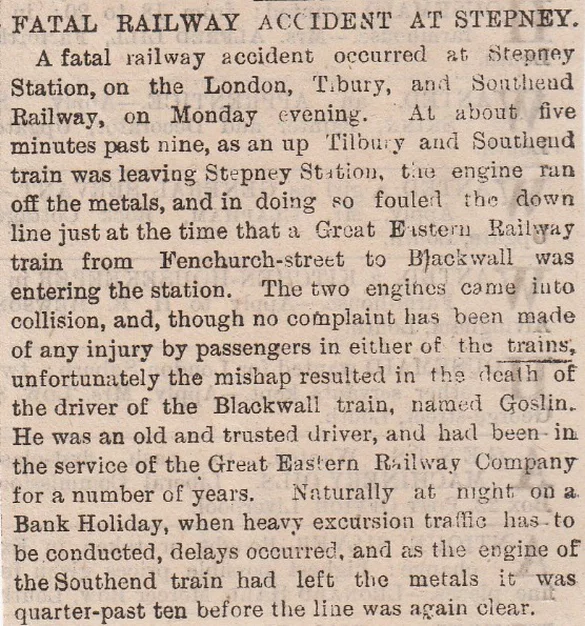
41/ Clamis Road Murder, Shadwell, October 1902
A young girl was walking along Clamis Road in Shadwell minding her own business, when a man who was stood waiting on the other side of the road, suddenly ran across and stabbed her three times in the back, then a quick stab to the head. She was in a terrible state and was rushed off to the Children’s Hospital but died on her way there. Two passers-by overpowered the clearly insane man and held him until police turned up to handcuff him. The girl was identified as Emily Barrow and the murderer was the uncle of the girl, Thomas Barrow. Emily had obtained a summons against him for assault and it’s thought this was retaliation.
42/ Bethnal Green, August 1892 (Victorian Gang Fighting)
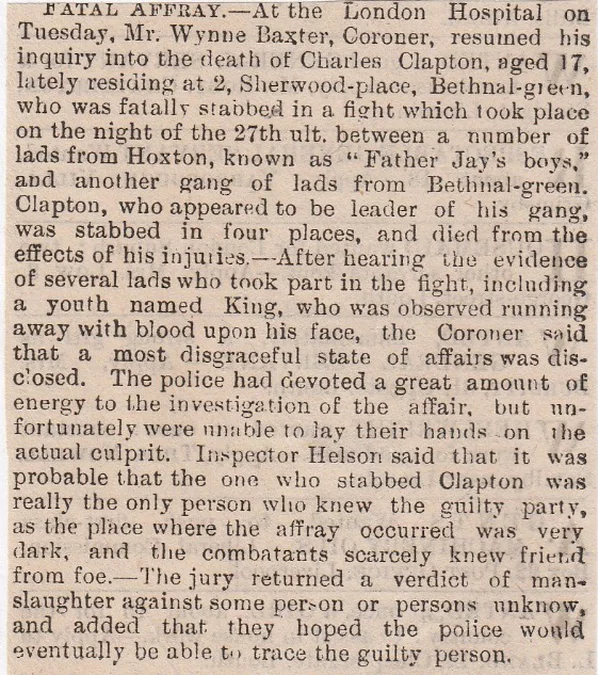
43/ Raven Row, Mile End, November 1844 (Double Suicide)
A double suicide occurred at No 9, Raven Row in Mile End, with two lovers committing the fatal acts, he being Charles William Duckett aged twenty-one and Elizabeth Williams aged twenty-two. They were childhood sweethearts and had been going out with each other for nine years, and during that time never a cross word was uttered by either of them. It was Charles’s father’s house that they killed themselves in. It was tea-time and they were now going to church. By eleven p.m. the family was frantic and two of her brothers turned up to Mr Duckett’s to see if either had been seen, but they replied in the negative. Now panic has set in and a search party was sent out to look in the immediate area, for the two lovebirds. At around two in the morning, Mr Duckett checked his son’s door, but it was locked from the inside. They broke it down and there lay the young couple on the bed, arms around each others neck. Cups on the bedside table smelled strongly of prussic acid. Charles had been unemployed for some time, so he must have talked Elizabeth into suicide.
44/ Grosvenor Buildings, Poplar, August 1896 (From Affluence to Want)

45/ Dorset Street, Spitalfields, July 1901 (Another Death in Same House )
Dorset Street in Spitalfields was the Victorian equivalent to modern day Bronx in New York. Really dangerous and with a high crime rate. This is the discovery of a body at No 35, which was the scene of the murder of Mrs Austin about a month ago. The corpse was that of a female in her mid-thirties and she was found in a locked cubicle, which was broken into by police to gain entry. The woman, who is a stranger to the area, arrived the previous evening at nine o’clock with a man in tow, and she was given cubicle 35 on the first floor. They both went upstairs and the next time she was seen the police were examining her. It is feasible that the severe bruising on her back was caused by having a seizure and this could be the cause of the poor girl’s death.
46/ Dorset Street, Spitalfields, March 1895 (Death from Starvation)
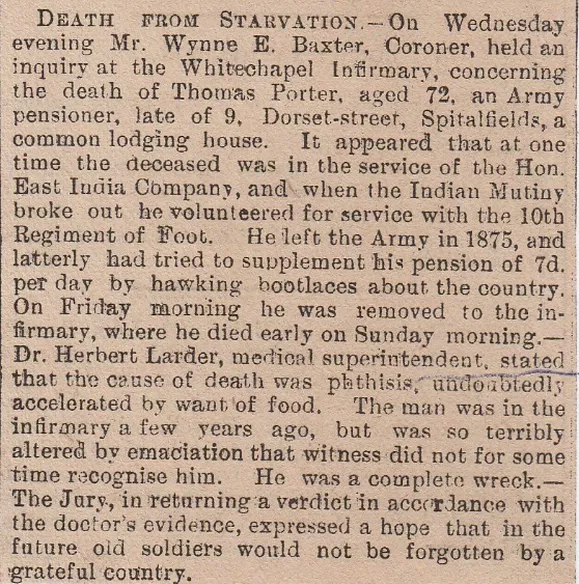
47/ Limehouse Suicide, May 1863
William Revell aged thirty-nine was caught with his trousers down, so to speak, as the husband of the woman he was seeing, Eliza Head, suddenly walked through the door after a trip to sea. The husband gave him a good kicking and a black eye then turfed him out onto the street. Eliza Head sent her little girl with sixpence for him, as she knew he hadn’t a penny to his name. This arrangement had been going on for about four years, that while hubby was at sea, Revell would go round and “plunge her depths”, to use a metaphor. He talked to the lock-keeper at Limehouse, about seeing her again and getting her to leave the husband and move with him to Bristol. He said that if she wouldn’t he would kill himself. The lock-keeper joked- “If you’re going to drown yourself, then do it in my lock, and I’ll get some money fishing out your body when you’re dead”. Strangely enough, he took that advice and his body was found near the lock of the Limehouse section of the River Lea.
48/ Whitechapel, July 1861 ( Girl’s Body Found in Church)
Workmen lifting up the floor-boards of a church found the dead body of a four-year-old girl, totally nude and lying horizontally. It is thought to be a body from a few years ago when the Secretary of State told them to clear the vaults out. It is also believed that it could have been due to be put in a coffin, but instead was left there. The surgeon stated it was a female aged four or five years old and hadn’t been there that long, but had been dead about a quarter of a century. The skin was hard and tanned and exposure to the atmosphere would not change the state of decay. He said it could stay in that condition for a few hundred years. There were no signs of violence, but her right foot was twisted. The little girl remains unknown. (What church was this in?)
49/ Spitalfields Murder, September 1885
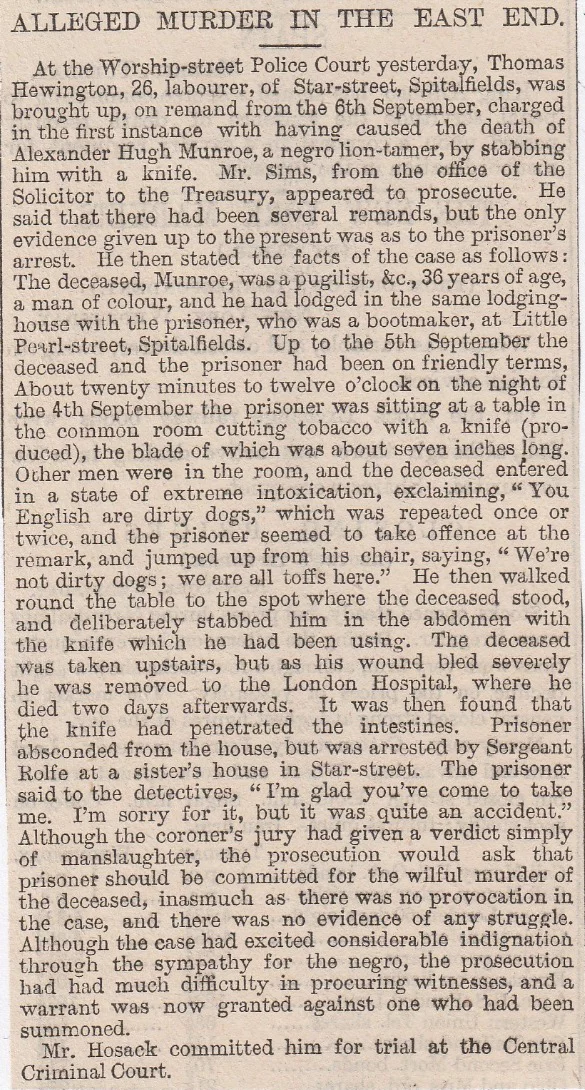
50/ No25, Trafalgar Square, Mile End, January 1896
This is a sad story of the squalor and destitution that some people had to endure in Victorian London. James William Lacey, a thirty-five-year-old labourer died from natural causes, but when you read of the circumstances you’ll understand why. Both he and his wife lived at the above address with their eight-year-old girl. They were both mentally deficient and the genes of the little girl were made her in the same mould. The neighbours called the sanitary inspectors to take a look at the place and when they entered one of them passed out from the smell. There wasn’t a scrap of food anywhere, the walls were covered in mould, there was hardly any furniture and the place was just a s**t-hole. He died of heart failure but the conditions in which he lived, brought this on.
51/ Bethnal Green, July 1862 (Insanity Suicide)
James Davey aged twenty-six decided to kill himself in the street as he was worried about the insanity that seemed to run throughout his family’s genes. His father had the same thing and it was hereditary. The witness to this outrageous suicide was William ward of no 25, Cambridge Road, Bethnal Green. He was walking down Mile End Road on Saturday morning and was opposite the almhouses, when he spotted Davey put a leather bag on the kerb, then put his head under the rear wheel of a huge cart. The wheel drove over his head, skidding it along and the back of his head became squashed and the brain matter came out. Death would have been nearly instantaneous.
52/ Bethnal Green, (Hysteria) March 1898
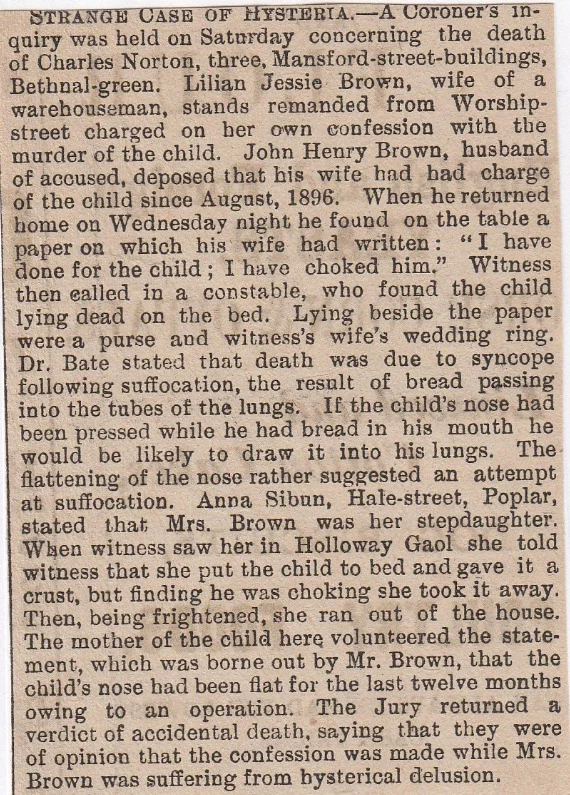
53/ Bethnal Green Workhouse Death, January 1916
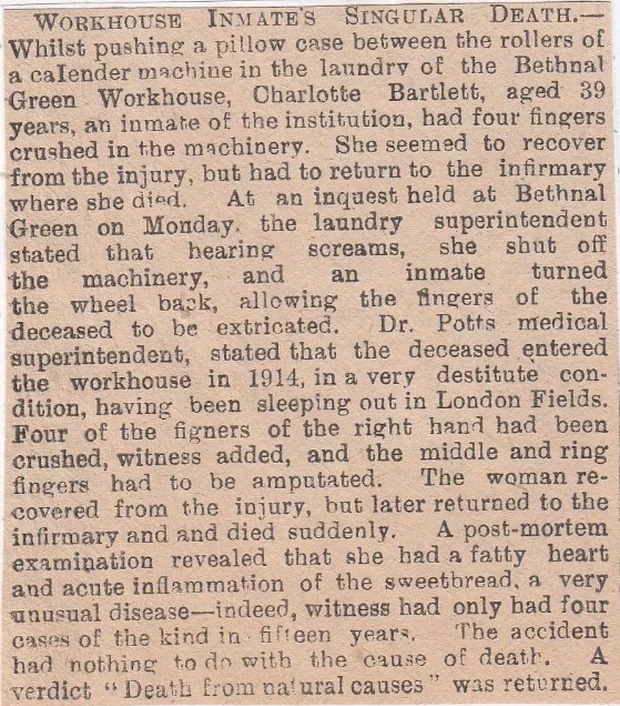
54/ Sir George Osborne’s Head Tavern Suicide, Spitalfields, June 1866
It’s not a pub named after David Cameron’s Chancellor of the Exchequer, but the suicide of seventeen-year-old Ann Williams, over some milk money, is strange, even for Victorian times. Mrs Jane Bird, the landlord’s wife, would send out Ann to get milk with some money she gave her to purchase it. Ann thought she could make some profit by buying milk at three pence a quart instead of paying the fourpence a quart that Mrs Bird had budgeted her for. Mr Bird was ill and needed the quality milk, and when she found out about her pocketing the remainder Mrs Bird gave her a telling off, but said she would take it no further. Then one evening, Mr Bird could hear running water in the yard, and on inspection, there was Ann Williams upside-down in a water butt. It was thought to be the shame of being caught thieving that preyed on her mind and this had caused her to commit suicide
55/ Haremarsh, Bethnal Green, January 1916 (Gruesome Mystery)
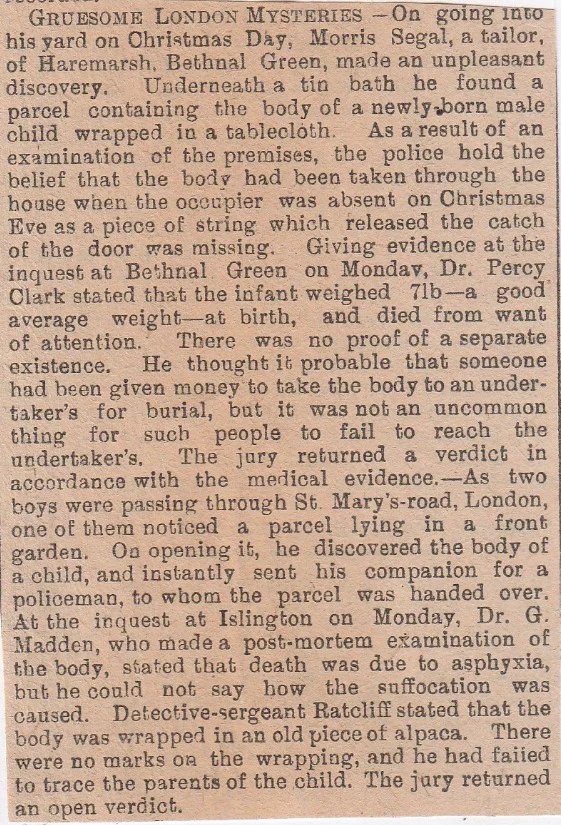
56/ St Georges-in-the-East, December 1885 (Sister Murder)
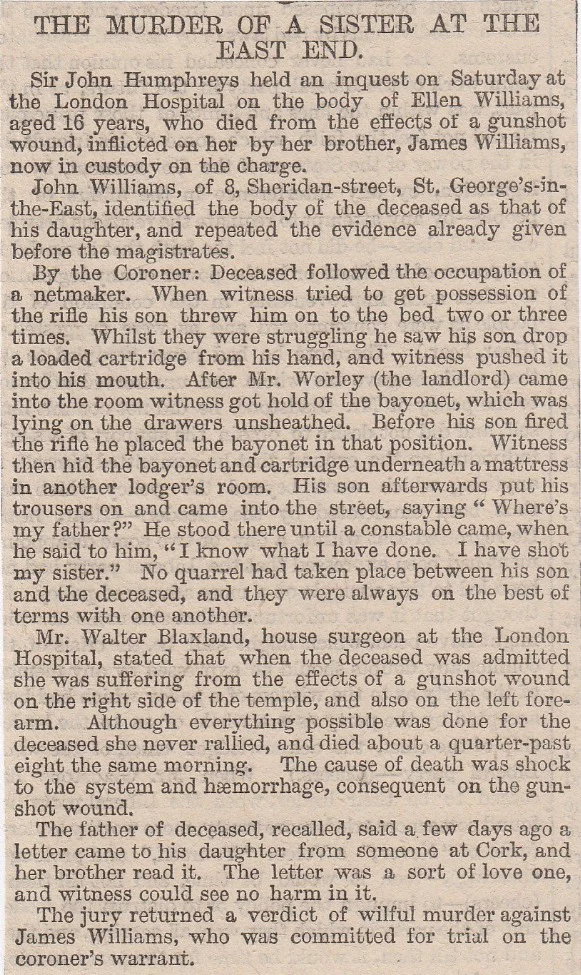
57/ East India Docks/Poplar, August 1896 (“Dunvegan Castle” was part of Castle Line Fleet, of the Union Castle Line)
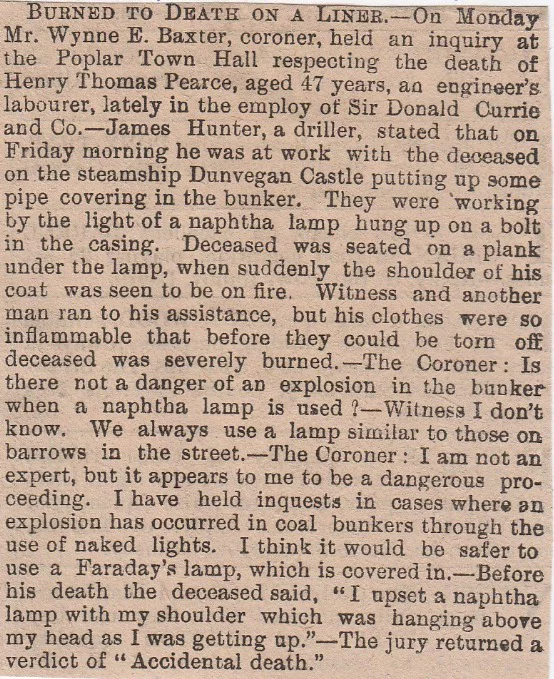
58/ Although not mentioned, it was in Spitalfields, February 1899
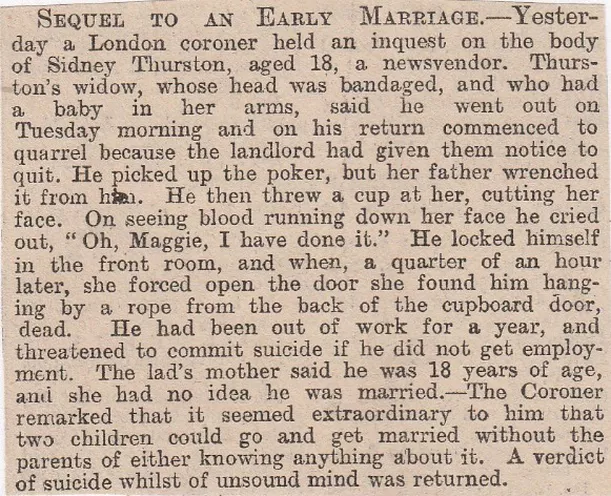
59/ Whitechapel Murder, October 1875
The two prisoners, Henry Wainwright and Thomas Wainwright have been committed for trial, were on Tuesday last removed from Horsemonger Lane Gaol to the prison at Newgate, preparatory to their trial, which in the ordinary course would come on at the next session of the Central Criminal Court, commencing on Monday the 25th inst. The prisoner Thomas appears to have quite recovered from the illness he was suffering last week and which prevented his removal at an earlier period.
60/ Shadwell Pub Murder, March 1879 (Execution at Newgate- James Simms)
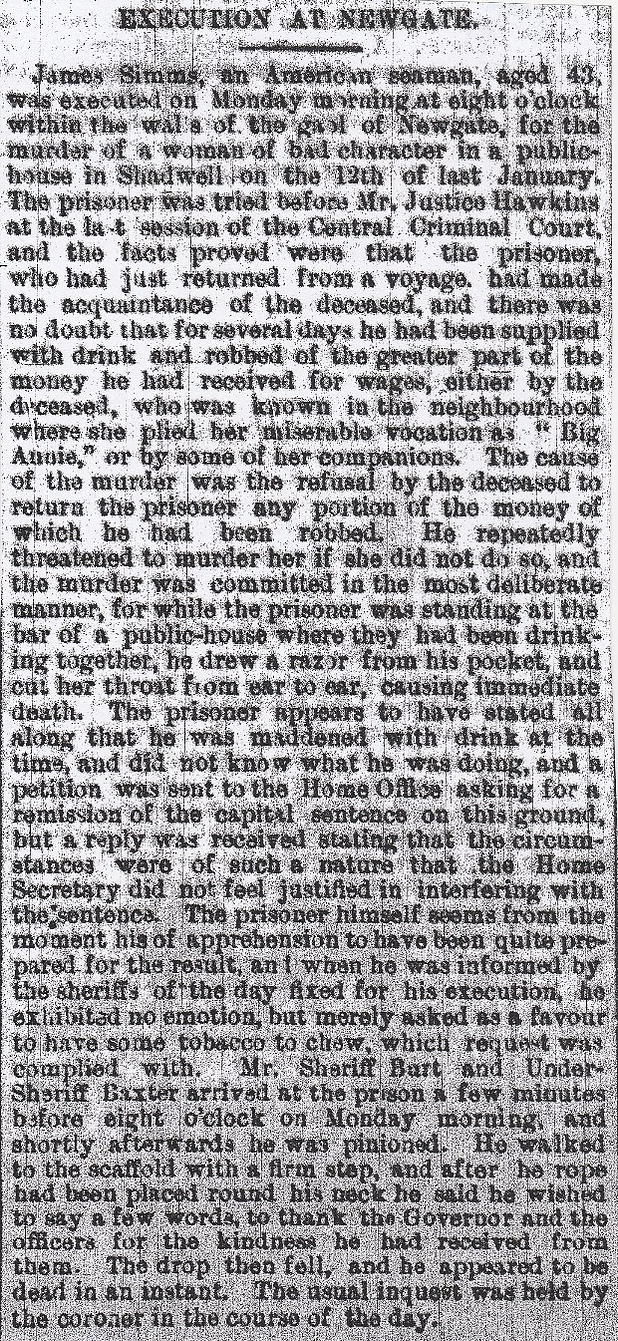
61/ Poplar Murder Victim, December 1888
The woman who was recently found murdered at Poplar has been identified by the head nurse of the Bromley Sick Asylum as Rose Millet, or Mylett, who has been an inmate of the institution on several occasions and was discharged from it in March last. Millet is believed to be her real name, though she was known by other names in Poplar and Whitechapel.
62/ Whitechapel Murder, April 1888
At an inquest at London Hospital on Saturday, on Emma Elizabeth Smith aged forty-five, widow, who was waylaid then robbed and barbarously murdered in Whitechapel while returning home late on Easter Monday evening. A verdict of “wilful murder against some persons unknown” was returned. The evidence showed that deceased was set upon by a number of young ruffians who first robbed her, then outraged her and ruptured the perineum by means of a blunt instrument, causing fatal inflammation.
63/ Spitalfields Disaster Suicide, February 1887

64/ East India Dock/Poplar, November 1903 (Ships Surgeon Poisons Himself)
